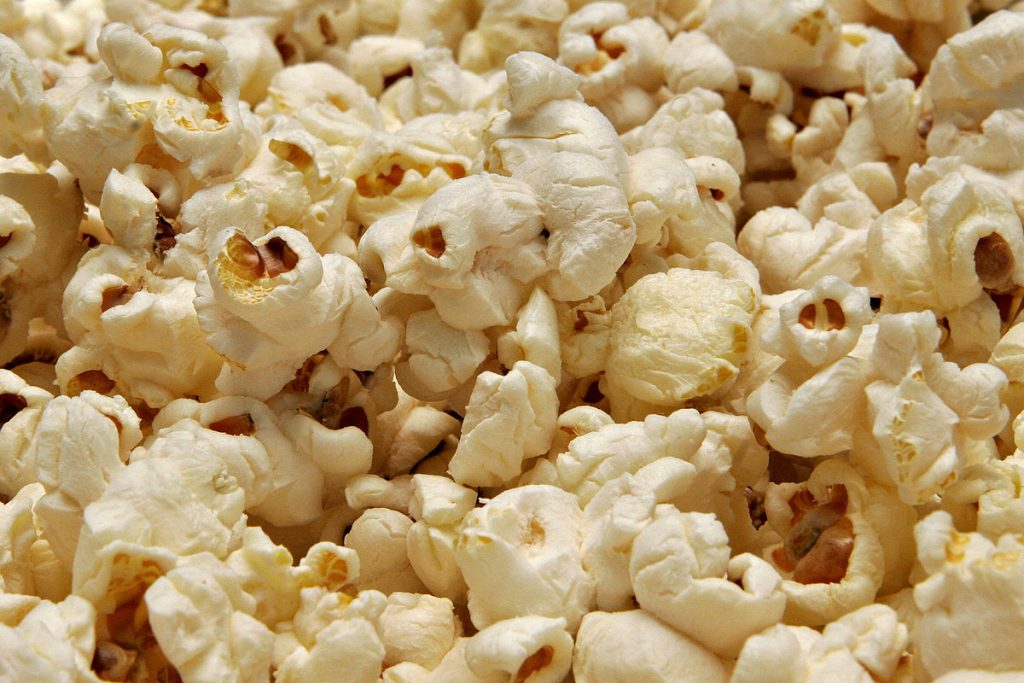How Popcorn Became a Movie Theater Thing

Movies and popcorn go hand-in-hand. If you shell out the $13 (okay, more like $15) for a ticket, you’re probably not going to balk at a medium popcorn for $4.75. It’s something that Americans have done for generations — although it doesn’t necessarily make sense. We can definitely go two to three hours without eating, and even if we did need sustenance that often, the empty calories plus salt and fake butter aren’t going to meet our nutritional needs. During the film, the crunching of as your neighbor munches away can be distracting. And at the end of the film, there’s almost always a good amount of popcorn and other sticky mess on the floor. If popcorn-eating weren’t so ingrained in our culture at this point, maybe we’d not do it.
So, why do we? Historically speaking, that is, whose idea was it to sell popcorn in movie theaters?
Movie theaters themselves have been around since the very early 1900s; one of the first dates back to 1905. That year, a pair of entrepreneurs in Pittsburgh opened what was known as a “nickelodeon,” a storefront theater which played silent movies on a continuous loop. Patrons, for the cost of one nickel, could watch for as long as they wanted. The business proved popular, spreading throughout the United States over the course of a decade, but ultimately nickelodeons were too successful for their own good. As a trip to the movies became more and more popular, these small theaters needed to expand. Unable to do so, they were replaced by large venues.
For the next decade or two, these new movie theaters saw themselves in competition with live theater, and if you went to one of these early movie theaters, you’d be in for a fancy experience. As the New York Times reported, “after you bought a ticket, you might pass through gilded archways and ascend a grand staircase lighted by a crystal chandelier to find your velvet seat.” It was more like a visit to a modern opera than to the next Avengers movie. And just like the opera, popcorn — and for that matter, food and drink in general — wasn’t welcome within.
By then, though, popcorn had become a popular street food. In 1885, a Chicago inventor named Charles Cretors developed a way to pop kernels using steam and without the need of a kitchen. Street vendors popped up in urban areas, including near theaters. Much like today, some theatergoers would buy a snack on the street in hopes of sneaking it into the movies, and similarly, theaters would discourage this behavior, Per Smithsonian, “early movie theaters literally had signs hung outside their coatrooms, requesting that patrons check their popcorn with their coats.”
In 1929, though, that began to change. The Great Depression gripped American society and like everyone else, movie theaters were feeling the pinch of lower demand. Unless they modified their business models, they’d be at risk of bankruptcy. So they adapted. Instead of preventing patrons from buying popcorn and sneaking it into the movies, many theaters partnered with the popcorn vendors to provide snacks for their guests. Yes, that meant the velvet seats could end up getting a bit gross, but it was better than the alternative. One company, also per Smithsonian, accidentally proved the point: “a Dallas movie theater chain [ . . . ] installed popcorn machines in 80 theaters, but refused to install machines in their five best theaters, which they considered too high class to sell popcorn. In two years, the theaters with popcorn saw their profits soar; the five theaters without popcorn watched their profits go into the red.” Popcorn allowed the movie theaters to survive.
Today, the same is still true. Most movie theaters make more money from the concessions than they do the films. As CNN reported, “most of the money from ticket sales goes back to the movie studio,” and if it weren’t for the snacks, the theaters would likely go out of business.
Bonus fact: Popcorn kernels pop in two different types of shapes, known as “butterflies” and “mushrooms,” as seen here. If you’re eating pre-packaged, pre-popped popcorn at home, you’re most likely eating mushroom-shaped kernels as they tend to be more resilient. Movie theater popcorn comes in both shapes but butterfly-shaped ones, per Wikipedia, “are regarded as having better mouthfeel, with greater tenderness and less noticeable hulls .”
From the Archives: Pop Goes the Kernel: Why popcorn kernels pop.
